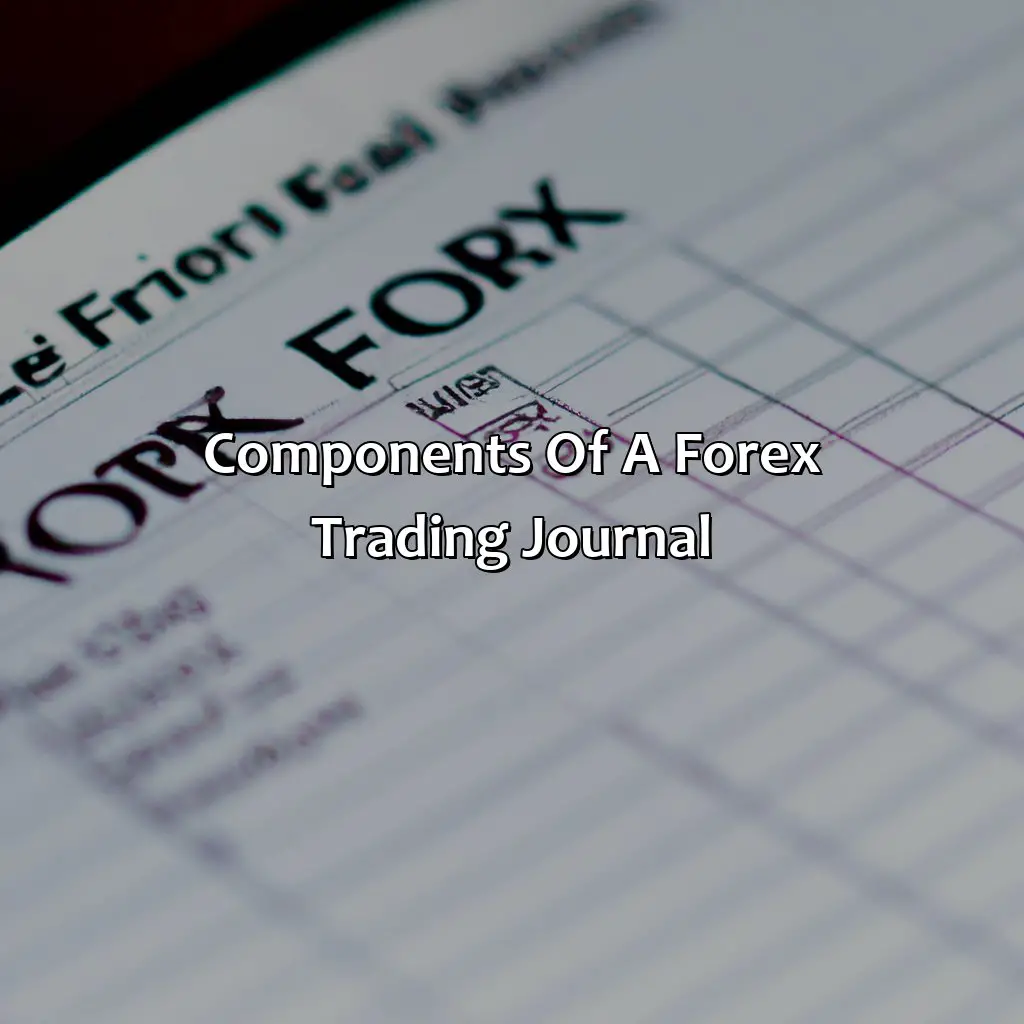To amp up your trading success, it’s important to keep a Forex trading journal! This should record trading psychology, habits, personal growth, self-awareness, goal setting, analyzing performance, trading improvement, risk and financial management, trader mindset, and trading discipline.
The first sub-section: track your trades, including any mistakes. Learn from your losses and wins, and plan your trading strategy. Also, track your progress.
TraderSync
TraderSync is one of the worlds leading forex trading journals. The platform automatically imports your trades for you to add comments, filter and analyse in order to increase your edge in the markets. The benefit of TraderSync is the fact the platform works in all markets including forex, stock, futures and options.
- Cheap
- Easy To Use
- Great Reporting
- Industry Leader!
The second sub-section: recognize patterns, enjoy the benefits of journaling, develop a trading routine, stay consistent, build helpful habits, and focus on trading objectives and targets.
Tracking Trading Results
Tracking the progress of your Forex trades is critical to learning from your mistakes and successes. By keeping a record of each trade, you can gain valuable insights into your trading strategy, identify trends in performance and continuously improve your approach.
When you lose a trade, it can be tempting to brush it off and move on. However, by documenting the details of the trade, including entry and exit points, currency pair traded, position size and emotional state during trading, you can look for patterns that contributed to the loss. This allows you to adjust your trading plan accordingly.
Just as losses are an opportunity for improvement, wins offer key lessons as well. Reviewing successful trades gives insight into profitable strategies and helps you replicate those actions in future trades.
By tracking your trades over time and analyzing performance metrics, such as win/loss ratios or profit margins, you can identify areas where your strategy may need adjustment. With this insight in hand, you can develop a stronger trading plan that minimizes risk while maximizing potential gains.
It is also worth noting that tracking progress shouldn’t stop at merely recording profits and losses. A comprehensive journal includes details about market conditions at the time of the trade or any significant news events that may have impacted performance.
To keep an effective trading journal:
- Select a format that works for you: whether using pen-and-paper or digital tools.
- Create consistent entries for every trade; track all relevant details.
- Dedicate regular intervals (such as monthly) to analyzing entries to identify key takeaways.
Ultimately, learning from mistakes is part of the game when it comes to Forex trading – but leveraging detailed records of trades through an accurate journal takes these lessons further.
Journaling doesn’t just track your trades, it tracks your soul – helping you identify patterns, make improvements, and become a better trader overall.
Identifying Trading Patterns and Making Improvements
Regularly journaling the details of each forex trade not only tracks trading results but also facilitates self-reflection and gaining valuable trading insights. Identifying recurring patterns in trades can lead to making improvements in trading behavior, ultimately increasing profitability. A trading journal allows traders to observe their trading routine and consistency, identify areas for improvement, and develop personalized journaling techniques that create effective trading habits. Focusing on goals, objectives and targets within daily trading routine through a Forex Retail Broker can help traders achieve long-term success.
Record your trades, analyze your data and discover profitable trading patterns with the components of a Forex trading journal.
Edgewonk
Edgewonk combines journalling and a trading diary to provide a great analysis tool for forex traders looking to improve their edge. The tool works on all devices and comes with a trade simulator, data filters, graphs, multiple journals and a notebook for screenshots!
- Cheap
- Easy To Use
- Great Reporting
- Industry Leader!
Components of a Forex Trading Journal


Photo Credits: forexbrokerreport.com by Terry Moore
Keeping track of your Forex trading? You need an accurate journal! Record trades, analyze data, evaluate patterns + trends. Technical, fundamental + sentiment analysis for currency pairs using tools.
Now for the components of a trading journal:
- dates + times of trades
- currency pairs
- entry + exit points
- position size
- strategy
- and your emotions during trading
Dates and Times of Trades
When recording trade transactions in a forex trading journal, it is essential to note down the exact dates and times of trades executed. This information helps traders identify any interrelation between market events and currency movements.
| Column 1 | Column 2 | Column 3 |
|---|---|---|
| Date | Time (GMT) | Currency Pair Traded |
| 2021-05-14 | 15:02:17 | EUR/USD |
| 2021-05-17 | 08:34:54 | AUD/JPY |
It is crucial to note down the dates and times of trades as they aid traders in creating a detailed record of their trading activities. Additionally, having such data at hand helps identify specific market trends and patterns that can guide future decision-making.
Recalling the correct dates and times of trades might become challenging for some traders as time passes by, but it is vital to take note of every detail when executing trades. By doing so, traders can avoid forgetting key details about their trades that could come back to affect profitable decision-making.
In an interesting study conducted among successful forex traders who maintain trading journals, all participants emphasized recording the dates and times of trades accurately to be a fundamental aspect of the process. Doing so makes a significant difference in identifying weak spots and improving areas for better market performance.
Trading with the wrong currency pair is like trying to swim with a brick tied to your ankle.
Currency Pairs Traded
Forex traders need to record and track the ‘currency pairs traded’ to analyze their trading performance. It helps in identifying profitable currency pairs and avoiding unproductive ones. A trader can analyze their past performance with a specific pair and devise a strategy accordingly.
The following table showcases an example of how a forex trading journal may record the ‘currency pairs traded’.
| Date | Currency Pair | Entry Point | Exit Point | Profit/Loss |
|---|---|---|---|---|
| 01/01/22 | USD/EUR | 1.2000 | 1.2100 | +100 |
| 01/02/22 | USD/JPY | 109.00 | 108.50 | -100 |
It is essential to note down the accurate currency pair in the trading journal, reflecting their positions’ overall movement towards profit or loss.
Currency pairs traded data can also help a trader maintain portfolio diversification and avoid risks by analyzing correlations and negative impacts between different currencies.
To further improve their trading, traders can focus on market trends while studying patterns made by different currency pairs traded over time, as it will assist them in making informed decisions on buying or selling.
To make the best use of recording currency pairs traded, forex traders should consider using categorically organized tables and ensure that they are logged consistently; this practice results in providing factual evidence for research purposes.
Traders can turn each trade into analysis and learn from both profitable and loss trades gathered through a journal, over several years; it all comes down to the proper formatting, consistency, and persistence for maintaining trade records efficiently.
Entry and exit points – where the rubber meets the road and your heart meets your throat.
Entry and Exit Points
It is important to carefully track the entry and exit points of trades in a Forex trading journal. This allows traders to evaluate their performance and make informed decisions for future trades based on their previous experiences.
Here is a 4-Step Guide to tracking entry and exit points in a Forex Trading Journal:
- Record the time and date of each trade.
- Document which currency pairs were traded.
- Clearly note both the entry and exit points of each trade.
- Keep track of any stop loss or take profit orders that were placed.
By following these steps, traders can gain valuable insight into their trading strategies and identify areas for improvement.
It’s also important to note how market conditions may have influenced these entry and exit points, as well as any emotions that were experienced during the trade.
Pro Tip: While it may seem tedious, accurately tracking entry and exit points in a Forex trading journal is essential for becoming a successful trader. By analyzing patterns in previous trades, traders can adjust their strategies and ultimately improve their overall profitability.
Size matters – why keeping track of position size is crucial in your Forex trading journal.
Position Size
The quantity of currency purchased or sold during a Forex trade is referred to as Position Size. It is important to maintain a record of the position size for every Forex trade in your trading journal. The position size can help you evaluate your risk management strategies and determine the profitability of your trades.
Here is a table that gives an example of how you could structure the ‘Position Size’ component in your Forex Trading Journal:
| Trade Date | Currency Pair | Entry Point | Exit Point | Position Size (Units) |
|---|---|---|---|---|
| 01/01/2022 | EUR/USD | 1.2500 | 1.2600 | 10,000 |
| 02/01/2022 | USD/CAD | 1.3100 | 1.2900 | 15,000 |
By recording and analyzing the position sizes for each trade, you can identify patterns in your trading style and correct any inconsistencies.
It is also crucial to adjust and calculate position sizes according to market conditions and account balance. This component can be used as part of your overall risk management strategy by calculating the number of units or lots based on your account balance and stop loss levels.
Pro Tip: Always be aware of the potential risks when increasing or decreasing position sizes, as they have a direct impact on profit or loss ratios.
Your trading strategy is like a fingerprint, unique to you and only you can master it.
Trading Strategy Used
Having a solid trading strategy is fundamental for achieving success in forex trading. A trader’s strategy may involve technical analysis, fundamental analysis, or a combination of both. Documenting the trading strategy used in each trade can provide insight into which methods work best and help traders to adjust their strategies based on past results.
When documenting the trading strategy used in a forex trading journal, the following six points should be considered:
- The specific indicators or signals that were used to identify entry and exit points
- The types of orders that were placed (such as limit orders or stop-loss orders)
- The timeframes analyzed for market trends and support/resistance levels
- The risk management techniques utilized (such as position sizing and setting stop losses)
- Any news events or economic data that factored into the decision-making process
- The trader’s overall goal for the trade (such as short-term profit-taking or long-term investment)
By recording this information, traders can reflect on their performance in accordance with different strategies, and adjust their approaches accordingly. Regularly analyzing journal entries including information on “trading strategy used” can also lead to an understanding of market trends and identifying new opportunities beyond those missed previously.
A pro tip for developing a successful trading journal system would be to keep things simple yet granular. Avoid using complicated jargon or buzzwords while describing your strategy but perhaps delve deeper into certain concepts with more detail when necessary.
Keep your emotions in check or risk losing your shirt – the importance of tracking your emotional state during trading.
Emotional State During Trading
During Forex trading, traders’ emotions can have a significant impact on their decision-making process and overall performance. Keeping track of one’s emotional state during trading is crucial to understanding what factors lead to profitable or unprofitable trades. By monitoring emotions like anxiety, greed or fear whilst trading, traders can develop better habits and avoid making impulsive decisions which may ultimately lead to losses. As such, tracking emotional states during trading is an integral part of efficient forex journaling.
When analysing the emotional state during trading, traders should consider any emotions that may have impacted their trades. For instance, feelings of stress or frustration may lead a trader to hold onto losing positions for too long in a bid to recoup lost profits. On the other hand, overconfidence can prompt one to take unnecessary risks and potentially result in significant losses. By keeping a record of their emotional state when entering and exiting trades, traders can gain insight into habitual patterns of behaviour and how they correspond with certain market conditions.
It’s essential to supplement emotional data with other crucial information in order to derive meaningful insights from forex journals. A detailed analysis of one’s currency pairs traded, as well as entry and exit points for trades can provide valuable data when considering how emotions affect performance. Additionally, successful traders’ experiences can inspire journal-keeping methodology that favours both internal (emotional) and external factors affecting FX trade outcomes.
Successful Forex traders such as Kathy Lien have been vocal about their use of financial journals throughout their careers. By documenting each trade in detail through a journaling practice that includes tracking one’s emotional state during trading activity—success rates are seen because the trader learns from his/her mistakes quickly When used consistently for strategically optimizing trade entries/exits sizes/types etc., Forex Trading Journals prove irreplaceable at all levels where paperwork offers solid solutions beyond software-based recording systems due naturally occurring human error-prone flaws.
Successfully completing comprehensive forex journals enables many possibilities for the traders’ portfolio to include: refined trading strategies, a more precise understanding of position sizing for each market, active monitoring of emotions at key moments during trading events which always lead to improvements. Ultimately, there is no doubt that keeping a forex trading journal that incorporates emotional states is well worth it – helping traders learn from their mistakes while simultaneously nurturing behavioural patterns necessary for sustained success in a highly competitive industry.
Don’t leave your forex success to chance- create and maintain a trading journal like a pro.
How to Create and Maintain a Forex Trading Journal


Photo Credits: forexbrokerreport.com by Jack Nguyen
Creating a successful Forex trading journal has many benefits. To do this, follow these three steps:
- Select a format that works for you.
- Log your trades consistently.
- Analyze your journal entries regularly.
This will help you make better trading decisions, journal your emotions, and identify patterns.
Selecting a Format
Selecting a suitable format for a Forex trading journal is an important aspect that requires attention. A well-structured and organized format can help traders keep track of their trading activities, identify potential strengths and weaknesses in their strategies, and make informed decisions to improve their performance.
Here are six points to consider when selecting a format for a Forex trading journal:
- Choose a user-friendly format that suits your individual preferences.
- Select a digital or physical format based on your convenience.
- Incorporate all essential elements discussed in paragraph 3.
- Add relevant notes, comments, and insights for improving future decisions.
- Simplify the process by automating data entry and analyses if possible.
- Be consistent with the chosen format throughout your trading journey.
It is important to note that selecting the right balance between simplicity, comprehensiveness, and functionality is crucial in developing an effective Forex trading journal. Once the preferred method has been chosen, traders should adhere to it consistently to ensure accurate and reliable data.
Pro Tip: Keeping multiples formats or double-dipping between them may cause confusion leading to ambiguous tracking of trades. It is better to stick with one systematic approach than juggling between multiple formats.
Don’t let inconsistency be the only thing you consistently log in your trading journal.
Logging Trades Consistently
Traders must maintain consistency while recording entries in their Forex trading journals. Accurately document trades, including currency pairs and entry/exit points, for future analysis. Logging trades consistently not only helps identify successful strategies but also saves time in the long run. A daily routine of note-taking and analysis helps traders remain accountable, focused, and offers an insight into emotional tendencies that may impact decision-making. By logging trades consistently and regularly reviewing entries, traders develop a clearer understanding of their strengths and weaknesses when it comes to developing winning Forex trading strategies.
Keep your journal close and your trades closer, regularly analyzing your entries can turn an average trader into a profitable one.
Analyzing Journal Entries Regularly
Regularly reviewing and evaluating forex trading journal entries is a crucial aspect of becoming a successful trader. This practice helps to identify patterns in trading behavior, highlight strengths and areas for improvement, and adjust strategies accordingly. By analyzing journal entries regularly, traders can gain valuable insights into their trading performance, develop better self-awareness and control over emotions while trading, and make informed decisions based on data rather than intuition.
To effectively analyze journal entries regularly, traders must create an organized format that includes all the relevant information about each trade. Traders should pay close attention to critical elements such as entry and exit points, position size, currency pairs traded, and their emotional state during trading. They should also take detailed notes on their trading strategy used for each trade.
Once this information is recorded in the journal, traders need to review it regularly to identify trends or patterns in their trades that may indicate strengths or weaknesses in their approach. This analysis can help traders refine their strategies further by adjusting risk management plans or identifying opportunities to take advantage of market conditions more effectively.
Pro Tip: Regular analysis of forex trading journal entries can be an effective tool for improving overall performance and profitability. Traders must commit to recording all necessary data consistently while maintaining objectivity during the analysis process.
Successful Forex traders know that a journal is the ‘must-have regulation’ in their trading environment, supported by a community and resources, to build a trader network with matching journal, diary, and notes.
Examples of Successful Forex Traders Who Keep Trading Journals


Photo Credits: forexbrokerreport.com by David Miller
Successful Forex traders keep trading journals as it helps them to improve their trading skills continuously. They use trader journals, Forex diaries, and trader notes to document their trading strategies, market analysis, and their reactions to market conditions. This journaling helps them to understand the trading regulations, trading environment, and the trading support available. Moreover, it helps them learn from their past mistakes and successes, refine their trading strategies, and stay focused on long-term goals.
These successful Forex traders have found that using a trader journal is a valuable resource for analyzing their trading performance, identifying areas that need improvement, and making necessary adjustments. By recording all trades, including the entry and exit points, stop-loss levels, and profit targets, they can evaluate their success rate and progress over time. Additionally, in the trading community, these trader journals and notes can help traders to build a trader network and to share ideas and strategies with other traders.
To maximize the benefits of using a trader journal or a Forex diary, it is essential to create a comprehensive and consistent system for documenting trades. This system should include best practices for recording timely and accurate information, identifying indicators of success, and identifying areas for improvement. By following these practices, traders can leverage their trading resources to achieve greater accuracy and consistency in their trading.
Five Facts About Forex Trading Journals:
- ✅ Forex trading journals help traders keep track of their trades, the reasons behind them, and the outcomes. (Source: Investopedia)
- ✅ Keeping a forex trading journal can help traders identify patterns, improve their strategies, and ultimately become more disciplined and profitable. (Source: DailyFX)
- ✅ A forex trading journal should include information like the date and time of each trade, the currency pair and associated metrics, and notes on the trader’s thoughts and emotions during the trade. (Source: The Balance)
- ✅ Forex trading journals can be kept in various formats, such as spreadsheets, notebooks, or specialized software. (Source: My Trading Skills)
- ✅ Most successful forex traders emphasize the importance of keeping a trading journal for long-term success. (Source: ForexTraders.com)
FAQs about Is A Forex Trading Journal Worth It?
Is a Forex trading journal worth it?
Keeping a Forex trading journal is an essential tool for any trader, as it can help you track your progress, make informed decisions and improve your trading strategies. Here are some frequently asked questions about the importance of maintaining a Forex trading journal:
What should be included in a Forex trading journal?
A Forex trading journal should contain information such as the date, time, currency pair, trading strategy, entry and exit points, profit or loss, and any notes or observations you may have had during the trade. Including screenshots or charts can also be helpful for reviewing your trades in greater detail.
How can a Forex trading journal help improve my trading skills?
A trading journal can help you identify patterns in your trading behavior, track your progress over time, and learn from your mistakes. By analyzing your past trades, you can identify what works and what doesn’t and make adjustments to improve your overall performance.
Can a Forex trading journal help me stay disciplined?
Yes, maintaining a trading journal can help you stay disciplined in your trading approach. By tracking your results and learning from past mistakes, you can develop a more methodical and disciplined approach to trading.
Is it important to review my Forex trading journal regularly?
Yes, reviewing your trading journal on a regular basis can help you identify patterns, evaluate your performance, and make any necessary adjustments to your trading approach. By regularly reviewing your journal, you can stay on top of your trading game and continue to improve your skills.
Are there any tools available to help me maintain a Forex trading journal?
Yes, there are numerous software programs and apps available that can help you easily maintain a Forex trading journal. Some of the most popular options include Excel spreadsheets, MyFxBook, and TradingDiary Pro.




